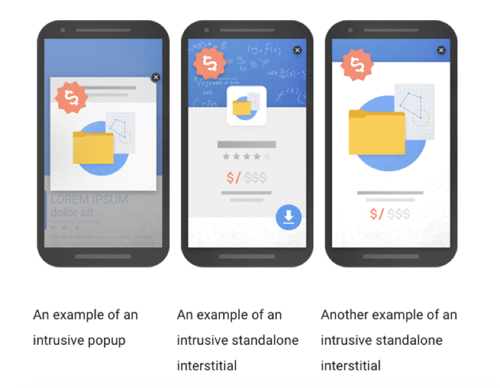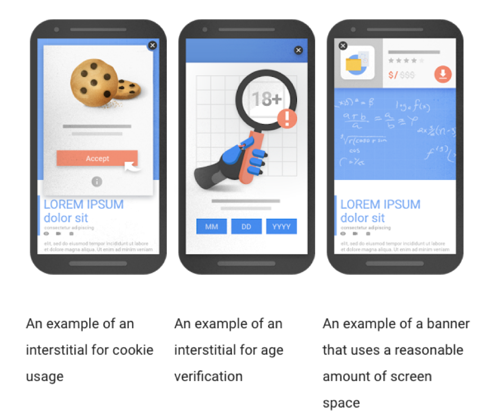Google to penalise mobile sites using intrusive pop-ups
For some time now, Google’s mission has been to make it easy for users to access information while on the go. They’ve encouraged sites to be mobile-friendly by sharing information and tools to help site owners figure out what makes a good mobile site. So it’s no surprise that now they’re taking a stand against another issue which is preventing users from accessing information easily and immediately: pop-ups.
Google has announced that it will begin downgrading sites that use “intrusive interstitials”, commonly known as pop-ups. So, starting January 10, 2017, the search engine giant will be penalising sites that use excessive pop-ups by lowering their rankings in the mobile search results.
Google rarely warns people ahead of time when it comes to updates and changes to its algorithm, so when they do, you know they should be taken seriously.
Take Mobilegeddon, which was just released in 2015. This update was announced ahead of time to give businesses the opportunity to adjust their strategies. But not everyone took the warning seriously. Just look at these stats:
- 21% decrease in non mobile-friendly URLs on the first 3 pages of search results.
- Traffic to non-mobile-friendly websites from Google mobile searches fell 12% in the two months after the changes took effect, according to a report from Adobe System.
The update planned for January 2017 is considered to be part two of Google’s “mobile-friendly update”, targeting mobile sites using pop-ups that make it difficult for users to access the content they expect to see.
But why has Google decided to penalise sites that use pop-ups, and how can this affect your business’s visibility in the mobile search results? And are there still pop-ups that are safe to use on a site? Read on as we answer these questions and more.
What are “intrusive interstitials”?
Interstitials are pop-ups that can take up a user’s screen, obscuring the content that a user is expecting to see as they enter the site. In other words, it’s those annoying pop-ups that we deal with on so many sites before we get to the main content.
So, if you’re using pop-ups similar to the ones below, Google may penalise your site by lowering its search rankings (unless you fix this soon).
So, what’s wrong with these examples? Apart from the fact that they’re disruptive and they’re covering the content that I was expecting to see, it’s their timing too. They’re asking me to sign up before I’ve even had the chance to review the site. These are the key things that Google wants to fix, and sites that don’t comply will be downgraded in the search results.
Which pop-ups can get my site penalised?
In the post on the Official Google Webmaster Central blog, Google Product Manager Doantam Phan provided examples of the types of pop-ups that Google considers to be disruptive to the user experience:
- “Showing a popup that covers the main content, either immediately after the user navigates to a page from the search results, or while they are looking through the page.
- Displaying a standalone interstitial that the user has to dismiss before accessing the main content.
- Using a layout where the above-the-fold portion of the page appears similar to a standalone interstitial, but the original content has been inlined underneath the fold.”
Here is a diagram from Google to showcase the above points:
But why is Google penalising sites that use pop-ups?
The short answer: bad user experience.
Now here’s the longer answer. With over half of all searches on Google coming from smartphones, it’s no wonder Google is pushing for a great mobile search experience for its users. But what does that mean exactly?
It means having information easily available while on the go. But if the content that mobile searchers land on when they choose a page from the search results differs from what they were expecting to see, or if that content is obscured, that results in a poor user experience.
Google Product Manager Doantam Phan wrote: “While the underlying content is present on the page and available to be indexed by Google, content may be visually obscured by an interstitial. This can frustrate users because they are unable to easily access the content that they were expecting when they tapped on the search result.”
Apart from being intrusive and causing frustration, pop-ups can also slow down a site, which also has a negative impact on user experience.
So which pop-ups can I use on my site?
Not all pop-ups are bad. In fact, some are legally required, like asking permission to drop small pieces of code known as “cookies” on user’s devices, or asking to verify the user’s age:
So these won’t impact a site’s rankings.
Other pop-ups that Google said are acceptable “if used responsibly” include:
- “Login dialogs on sites where content is not publicly indexable. For example, this would include private content such as email or unindexable content that is behind a paywall.
- Banners that use a reasonable amount of screen space and are easily dismissible. For example, the app install banners provided by Safari and Chrome are examples of banners that use a reasonable amount of screen space.”
Here is a diagram from Google to showcase the above points:
What you can do to prepare
Here’s what you can do to get ready for the rollout:
- Remove any pop-ups you’ve been using if they’re disruptive to the users, unless they’re required by law like age verification displays and cookie policies.
- If you can’t be without pop-ups, try not to overuse them. Not only do they provide a bad experience and can attract a penalty from Google, but they can also slow down your site.
- Find other ways to attract subscribers and to generate revenue, without obstructing the user experience. Instead of using pop-ups, you could create valuable content for the user. Great content and strong calls-to-action can generate leads, and eventually sales, in a much less intrusive way. So not only are you giving your audience what they’re searching for, and improving your rankings at the same time, but you’re also getting rid of those annoying pop-ups that, come January, would be lowering your rankings.
Wrapping up
With this official announcement, Google is giving sites plenty of time to prepare and change if necessary. So use this opportunity to think about your users first and their experience on your site.
Lastly, Google reminds us of the most important part of any user experience in general:
“Remember, this new signal is just one of hundreds of signals that are used in ranking. The intent of the search query is still a very strong signal, so a page may still rank highly if it has great, relevant content.”
So what you need to remember is that if you’re being helpful and attentive to your mobile visitors’ needs, and if you are delivering the experience that they’re looking for, you’re already ahead of the competition.
What do you think about Google’s plan to penalise sites using intrusive pop-ups? And what are you doing to prepare? Let us know in a tweet @123reg.





